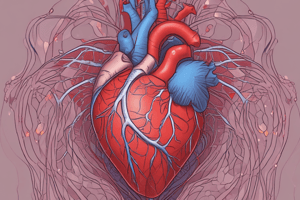Podcast
Questions and Answers
The heart's ability to pump blood depends on the following characterisstics:
The heart's ability to pump blood depends on the following characterisstics:
Automaticity = The ability to initiate its own electrical impulse Excitability = The ability to respond to electrical stimulus Conductivity = The ability to transmit electrical impulse from cell to cell within the heart Contractility = The ability to stretch as a single unit and then passively recoil while actively contracting
Match the Hormone and their primary sites
Match the Hormone and their primary sites
Norepinephrine, Epinephrine = Adrenal medulla Angiotensin = Kidney Vasopressin = Posterior pituitary Aldosterone = Adrenal cortex
Match the following
Match the following
Cardiac Output = The amount of blood pumped per minute Stroke Volume = Blood ejected with each myocardial contraction Mean Arterial Pressure = 1/3 SBP + 2/3 DBP Cardiac Index = The amount of blood pumped per minute per square meter of body mass
Match the Hemodynamics
Match the Hemodynamics
Match the hemodynamics
Match the hemodynamics
Match the following
Match the following
Type of Cyanosis - Decrease O2 level in arterial blood
Type of Cyanosis - Decrease O2 level in arterial blood
Type of Cyanosis - Decrease blood flow
Type of Cyanosis - Decrease blood flow
In peripheral cyanosis, oxygenation is normal compared to central cyanosis
In peripheral cyanosis, oxygenation is normal compared to central cyanosis
CENTRAL OR PERIPHERAL CYANOSIS
-venous obstruction
CENTRAL OR PERIPHERAL CYANOSIS -venous obstruction
Flashcards are hidden until you start studying
Study Notes
Pulse Abnormalities
- Pulsus alternans: regular rhythm with strong and weak pulse waves, indicative of left ventricular failure at normal heart rates
- Bigeminal pulses: every other pulse is weak and early, caused by premature ventricular contractions (bigeminy)
- Pulsus paradoxus: reduction in pulse strength with abnormal decline in blood pressure during inspiration, may be caused by:
- Chronic obstructive lung disease
- Pericarditis
- Pulmonary emboli
- Restrictive cardiomyopathy
- Cardiogenic shock
Pitting Edema Scale
- 1+: Trace - slight depression, barely perceptible
- 2+: Mild - 0-0.6cm depression, easily identified (skin rebounds in 30 seconds)
Studying That Suits You
Use AI to generate personalized quizzes and flashcards to suit your learning preferences.



